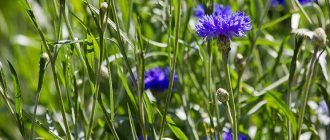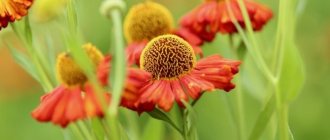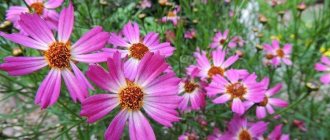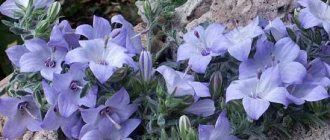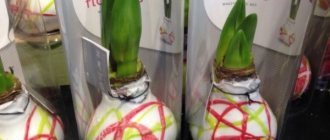Varieties and varieties of amaryllis
Amaryllis has only one species - Amaryllis belladonna. White or pink flowers look like large lilies; from 6 to 12 pieces grow on one peduncle. The leaves die off in the spring, and amaryllis blooms at the end of summer, which is why many, looking at a photo of a blooming amaryllis, try unsuccessfully to find leaves on it.
Amaryllis belladonna
Three varieties are most common in culture:
- Blanda. It is distinguished by large white but unscented flowers.
- Maxima. The inflorescences are pink, fragrant.
- Purpurea. This variety is famous for its large purple flowers that are yellowish inside.
Attention. Amaryllis juice is poisonous.
How to distinguish amaryllis from hippeastrum
Amaryllis and hippeastrum are often mistaken for the same species. They both belong to the same family and are very similar in appearance. But only amaryllis is suitable for growing outdoors. Unfortunately, gardening stores often sell hippeastrums under the guise of amaryllis. It is difficult to distinguish them without experience, because they have the same large bulbs and gramophone flowers.
Therefore, if you are just going to buy amaryllis, find out a few differences:
- The flowers of hippeastrum are very large and often reach 15 cm in diameter, while those of amaryllis are no more than 8 cm.
- Amaryllis has a strong peduncle with 8-12 flowers, while hippeastrum has a loose, tubular peduncle with 2 to 6 flowers.
- Amaryllis readily grows in the garden, and hippeastrum is an exclusively indoor plant.
- Amaryllis has a pear-shaped bulb, it quickly grows children, but in hippeastrum it is small and does not form children.
- Amaryllis produces a peduncle after the foliage dies, and during flowering the hippeastrum has both flowers and a leafy rosette.
- Hippeastrum blooms in winter, while amaryllis blooms in autumn.
Amaryllis in the photo:
Hippeastrum in the photo:
Planting in open ground
Most often this flower can be found in pots. There are reasons for this. Amaryllis is very thermophilic and does not tolerate wintering in open ground. But some gardeners successfully grow it in gardens. Areas with mild climates are more suitable for this. In the conditions of the middle zone, it will be more difficult to grow this crop in open ground. However, a flower that grows in open ground blooms more luxuriantly than its counterparts in pots.
To plant amaryllis, choose the sunniest and warmest place on the site.
Choose sunny places protected from the wind. The plant will feel good on the south side of buildings and among stones.
The soil should be well fertilized. It is also very important that the soil drains well. The bulb must be deepened by 15 cm and a gap of at least 30 cm must be maintained between plants.
Wintering
At the end of August - beginning of September, they stop feeding the flower and reduce the frequency of watering. At the end of October - beginning of November, watering is excluded. From this moment the leaves begin to fall, and by the end of the season the stems are completely bare.
It is not recommended to artificially remove the leaves, since during the process of dying, all the organic substances contained in them are transferred to the bulb. Thanks to this, the nutritional reserve necessary for future flowering is created. If 2-3 leaves remain for a long time, they can be carefully cut off at the base of the bulb or bent down.
During the dormant period, amaryllis in open ground should be watered once every 15-20 days. Containers with bulbs are stored in a cool, dry (5-12 degrees) place (pantry, greenhouse, garage, winter garden). The flower does not require lighting when at rest. The bulbs are left in this form for 8-9 weeks.
Important! Planting material does not tolerate low temperatures. Even a short-term cold snap can negatively affect the condition of the bulbs.
Preparations for wintering
Amaryllis care, fertilizer and feeding
The first shoots appear in the spring. Gardeners advise not to water the plant until the peduncle reaches 10 cm. Otherwise, the leaves will take all the strength necessary for flowering, and the peduncle will grow much slower. From now on, it is necessary to apply fertilizer once every two weeks. And water the crop as the soil dries, trying not to flood the bulb.
Feed your amaryllis regularly during the flowering period.
Since the peduncle is most often thin and long, you can make a support. If the flower has enough care, then by the beginning of autumn the amaryllis will begin to bloom. Flowering can last up to 8 weeks on leafless flower stalks. Towards the end of flowering, the plant will begin to produce leaves that should not be trimmed. After the amaryllis has faded, watering and fertilizing must be gradually reduced so that the crop enters the dormant phase.
Before the onset of cold weather, the bulbs are dug up and transplanted into pots that need to be placed in a warm, bright place.
Attention. Do not forget to water and feed the transplanted bulbs in winter, because at this time they gain strength for new flowering.
LiveInternetLiveInternet
Good evening, dear gardeners and indoor plant lovers. Two weeks ago I was at the market, accidentally met my grandfather, he was selling some strange bulbs with leaves and soil in a bag. I asked what kind of plant it was), and he replied that he didn’t know, but it was very beautiful. Said he dug it from his garden. Well, I bought two onions for one buck. I planted it in my garden, in open ground. Less than two weeks later, the flowers bloomed. It turned out to be amaryllis. And bad luck... I always thought it was a houseplant; my grandmother had one in a pot all her life, but it very, very rarely bloomed. I started looking for information on the Internet. Maybe some of you will find it useful too?
I’ll add later: in the comments they wrote that this is not amaryllis, but hipperastrum (I don’t even know))) should I be happy or what)))
This flower has been familiar to me since childhood. Out of habit, we call it amaryllis, although it is the most common non-varietal hipperastrum. We never part with it; it is our family heirloom. I'm sure it can be found in many other collections.
Amaryllis is a bulbous plant that blooms very beautifully. Its fragrant and large flowers can be different: white, red, pink, striped or plain in color. On a high peduncle, inflorescences are arranged singly or in several pieces. The flowers are very beautiful, but small and have no scent at all. All it needs is limited placement; it grows well on windows of eastern, southern, and western orientation. It is important for it to receive sufficient amounts of sunlight; in such conditions, this hipperastrum actively blooms and does not suffer from red burn of the bulb. Watering is moderate; between waterings the top layer of the earthen clod is allowed to dry.
Transplantation is carried out in the spring, in a mixture for amaryllis. This variety is good to plant in groups of several in a pot, then the flowering will be very long. For planting, you should not choose too spacious a container - then the plant produces many children and blooms poorly.
Question: Is it possible to grow amaryllis in a garden plot in open ground?
Answer: In summer, amaryllis can be kept in the garden outdoors in a flowerpot or tub. You can plant it on the site, taking it out of the pot, or you can dig it directly into the pot. True, in the fall it will be necessary to change the soil, since over the summer all kinds of living creatures will come into the pot that are undesirable for a potted plant if kept in winter, because for lack of other food it will begin to eat the roots and the bulb itself. And you shouldn’t injure the roots by replanting again, otherwise flowering will be postponed indefinitely. Amaryllis cannot overwinter in open ground, even with shelter.
Question: Why do the leaves dry out? And new ones grow to replace them right away...
(This is the second time this has happened to me in the short period of its existence.)
Answer: So this is the normal development cycle of plants, be it an indoor plant or growing outdoors! You’re not surprised by the annual autumn leaf fall, so why such a reaction to the change of leaves in indoor plants? Plant leaves do not last forever; new ones grow to replace old ones.
If the conditions are not suitable for the indoor plant, this process may occur faster and more often than necessary, and may become irreversible. Then the plant dies. Don't let it come to this
Question: The onion has no roots. How to root it?
Answer: Take regular soil from the site or buy universal soil, freeze for 6-8 hours, warm the soil to room temperature (+20-25°C), add the drug Kornevin to stimulate root growth. Add a 3-5 cm layer of coarse calcined sand to the bottom of the hole. Powder the bottom of the bulb with Kornevin and plant.
The height of the pot should be greater than its diameter, and the distance from the edge of the pot to the bulb should be 2-3 cm. Be sure to place drainage at the bottom of the pot; the pot must have a drainage hole. Do not bury the bulb; it should protrude a third above the soil surface. Water moderately, do not over-moisten the soil, otherwise the bulb will rot instead of rooting.
Question: How to distinguish amaryllis from hippeastrum?
Answer: Amaryllis can be easily distinguished from hippeastrum by the structure of the peduncle - in hippeastrum it is hollow (empty inside) and bears 1-6 large flowers, and in amaryllis the peduncle is completed (filled from the inside) and bears 8-12 large, drooping flowers . This is the surest distinguishing feature.
Leaves are formed after the flower arrow emerges or simultaneously, but not before. Another distinctive feature is that hippeastrum, unlike amaryllis, forms daughter bulbs irregularly.
Question: My bulb lost a lot of weight after flowering. How can I help her restore her volume?
Answer: An amaryllis bulb will only be able to “gain weight” in the next growing season if it is not allowed to bloom and the flower shoot is removed. And in the fall, do not cut off the green leaves, but wait until they turn yellow and return the nutrition spent on them to the bulb. Don't forget about feeding during the season.
In the garden, a well-lit place, for example an unshaded southern side, is best suited for amaryllis, since these are light-loving and heat-loving plants. The soil should be of light mechanical composition, that is, sandy or sandy loam; rich in humus with a high humus content is also suitable. Amaryllis prefers open, well-lit places and direct sunlight. Amaryllis is afraid of frost, so for the winter the bulbs need to be dug up and stored indoors, planted again with the onset of stable warmth. Amaryllis feels great in a well-lit place, loves a lot of light and really does not like coolness with drafts. Amaryllis can grow in light partial shade, but then the growth of the plant slows down.
Reproduction: amaryllis is propagated by regrown daughter bulbs - children, which can be separated from the mother bulb during spring transplantation. Already in the 2-3rd year, flowers appear from the daughter bulbs. If you want there to be many flowering arrows in one flower pot, the solution is simple - do not separate the children from the mother.
Feeding:
- spring-summer - once every 2 weeks with mineral and organic fertilizers;
- winter-autumn - without feeding.
Pruning: no need.
Care features: The plant is poisonous!
Transplantation: Amaryllis are usually planted in small flower pots in November-December. But with the same success you can plant in March-February. At the bottom of the pot, organize drainage from broken shards and only after that add a soil mixture consisting of turf, leaf, peat soil and sand (1: 2: 1: 1). Before planting, it is very useful to soak the bulb in a Humisol solution, and then plant it in a pot, burying it halfway into the ground. It is best to place the pot on the windowsill of a south-eastern or south-western window, since amaryllis is a light-loving plant. And don’t forget to water the planted bulb.
Small bulbs are planted together. Feed once every two weeks. After the leaves dry out, watering is almost stopped. Withered leaves are not cut off. Amaryllis are replanted every 4-5 years.
There is nothing easier than growing amaryllis: just a bulb, water and sunlight.
The bulbs have virtually no dormant period. After the plant has flowered, there is no need to do anything with the vegetative part and bulbs. It is enough to simply remove the flower stalks without affecting the leaves, as they will replenish the supply of nutrients in the bulb. After flowering, the bulb should be grown for 5-6 months.
As a houseplant, amaryllis is grown until early summer, but one should not forget about regular watering, and use standard fertilizers as top dressing. When the danger of frost has passed, the plant can be transplanted outside to a dark place.
To force amaryllis to bloom in winter, the bulbs must go through a dormant period. In August, you can stop feeding and gradually reduce the amount of water given. After three weeks, stop watering completely. Allow the leaves to yellow and wilt on their own. Cut the leaves at a height of 5 centimeters from the bulb.
In September or early October, plant the bulbs in a pot and place them in a cool (13-15°C), dark and dry place for 6-8 weeks. As long as at least one leaf remains green on the plant, it does not enter a dormant period. It is enough to put a pot of bulbs in the basement and forget about it for 2 months.
In November or later, place a pot of amaryllis in a lighted area, water it, and the vegetative cycle will begin all over again.
The soil should be damp, but under no circumstances wet. After flowering begins, do not let the soil dry out too much. Remember to rotate the pot daily to ensure the leaves grow evenly. The ideal temperature is 13–18°C. Higher temperatures weaken growth. Be careful: flowering should begin 4-8 weeks after watering the bulbs is resumed.
Possible reasons for lack of flowering: Immature or small bulbs, too short dormant period, very high temperatures during the growing season. It should be noted that the longer you have the bulb and the larger its size, the more flowers and leaves it produces, so it makes sense to store and use them year after year.
Reproduction
All bulbous plants: hippeastrum, amaryllis, lilies, tulips and others, reproduce by daughter bulbs, which are separated from the mother plant during transplantation. This is the easiest way to propagate such plants. Planting daughter bulbs is no different from planting the mother plant during transplantation: the composition of the soil and the height of planting the bulb are the same. The pot should be taken based on an adult onion. Young plants grow quickly and reach the size of the mother bulb in two years, and amaryllis often do not need to be replanted.
The second way to propagate amaryllis is by seeds. To obtain seeds, amaryllis flowers must be cross-pollinated with a brush and allowed to ripen. The process of seed ripening lasts about a month, after which they are immediately planted in the ground and watered well to keep the ground moist. In about a month, shoots will appear. When the plants grow, they are planted one at a time in small pots.
When propagated by daughter bulbs, a flowering plant can be obtained in the third year; when grown from seeds, amaryllis blooms in the 7th year.
Transfer
Transplantation is carried out after flowering has finished and the flower shoot has dried. The soil for planting is made up of equal parts of leaf, turf, humus soil and sand or purchased at a store for bulbous plants. The bulb, which was removed from the old pot, is freed from rotten roots and dry scales, from the children that form in the axils of the outer scales of the mother plant. The bulb prepared in this way is planted one at a time in a pot so that at least 1/3 of the height of the bulb is on the surface. You can leave it on the surface up to half the height of the bulb. The pot must have a layer of drainage, and it is advisable to pour a layer of sand under the bottom of the bulb. Amaryllis does not tolerate stagnant water. It is much safer to forget to water this flower than to flood it. The pot should not be too big. From the edge of the bulb to the edge of the pot, it is enough to have about 3 cm of free space.
Pests and diseases
Sometimes amaryllis can become affected by a fungal infection: red spots or stripes appear on the stem, flowers and bulbs. To prevent this disease, it is recommended to wet the plant as little as possible when watering. If the amaryllis does get sick, you can use special preparations: Bordeaux mixture, HOM or foundationazole.
So where is the best place to plant amaryllis?
Option one is open ground. Choose the best place for amaryllis somewhere in a sunny place, among the stones. Amaryllis looks very beautiful against the background of low-growing conifers. The “disadvantage” of such a planting is its strong dependence on weather conditions. In the event of late spring and early autumn frosts, heat-loving amaryllis will have to be carefully covered. And you will need to dig up its bulbs in the fall no later than the end of September (after all, in October the top layer of soil in the middle zone already begins to freeze slightly). And if your amaryllis just bloomed in September, then the bulb simply will not have time to ripen normally before digging it up. The “plus” of planting amaryllis in open ground is a stunning sight when, against the backdrop of falling leaves and autumn flowers, such a miracle suddenly appears from underground!
Option two is to plant amaryllis in a pot or any other container. You can install it on the balcony or directly in the flowerbed. By the way, no matter where you plant amaryllis, remember that you need to plant its bulb quite shallow. The top of the amaryllis bulb should be just visible above the soil surface (if you are growing amaryllis in a pot), or should be covered with a very thin layer of soil (if you are planting amaryllis in open ground). For the winter, it is better to put amaryllis bulbs on the bottom shelf of the refrigerator (along with gladioli); They are stored well and hardly dry out by spring.
Some of the information was found at https://www.botanichka.ru/blog/2010/01/01/amaryllis/
Marrietta
Amaryllis propagation
Amaryllis is most often propagated using the traditional bulbous method - by separating daughter bulbs. Small bulbs must be planted at the same depth in which they grew before transplanting. In two years, the young bulbs will already grow to the size of the mother.
Amaryllis bulbs
There is another way. You can divide a large onion into sections. The main requirement for the divisions is that each of them must have a piece of the bottom and several old scales. Some bulbs can even be divided into 30 or more parts. The sections must be immediately sprinkled with ash or crushed activated carbon. The central part of the bulb, on which there are the makings of leaves, is not used.
Delenki need to be planted in the sand and kept warm. In a month they will give the first leaves. When the second leaf appears, you can replant the plant in loose soil.
Amaryllis sprout
If you decide to try to propagate amaryllis by seeds, you should remember that the seeds lose their germination very quickly, so they need to be sown almost immediately after harvesting.
Attention. A flower grown from seeds does not retain maternal characteristics and blooms only in the seventh year.
Planting material
Amaryllis can be propagated by two main methods: seed and vegetative. They are equally successful, but it must be remembered that it takes 5 years for a plant that emerges from seeds to flower, and after the young bulbs are separated, the first flowers will appear after 3 years.
Seeds
It is quite difficult to get full-fledged seeds in a flower shop. This is due to the fact that high germination rates persist only for the first 6 weeks after ripening, and during this time the bag is unlikely to reach the buyer. But you can get seeds if someone you know has this flower at home.
In order for seeds to form, you need to use a cotton swab to transfer pollen from one inflorescence to the stigma of another. It is advisable to repeat this procedure twice at intervals of a day. For normal development, the temperature should be about 24°C. You need to collect seeds after about a month. A sign of full ripening is that the ripened boxes begin to crack.
Each seed contains the rudiment of a miniature-sized future bulb, so the bulge should be felt to the touch. It is better to plant immediately after collection. Growing takes place in a greenhouse - with the container covered with glass or film, but it is important to ensure that the soil does not become moldy. You can grow seedlings without a greenhouse, simply by controlling the soil moisture and preventing it from drying out. Seedlings develop to normal bulb size within 1.5 years, after which they can be planted separately.
Bulbs
Amaryllis bulbs can be purchased at a flower shop. When purchasing, you need to pay attention to the fact that they are at least 6 cm in diameter. The larger the bulb, the more likely it is to bloom after planting. It is important that it is not affected by mold, rot or looks dried out and wrinkled.
To initiate the appearance of bulbs at home, the peduncle must be removed immediately after flowering. After this, within a couple of months, many children will appear on the bulb, which can be planted.
In divisions
This method is the most difficult because it requires certain skills, but it is very effective and guarantees rapid flowering. It requires a large mother corm, which is peeled and carefully cut into a cross, not reaching the bottom. Matches, sticks or metal rods no thinner than 5 mm are inserted into the cuts to separate the parts. In this form, the workpiece is placed in the ground and grown. With moderate watering, 4 parts will form independent formed bulbs after 4 - 5 weeks. Within a year they can be planted and new plants can be obtained.
Diseases and pests of amaryllis
With proper care, this perennial flower rarely gets sick. Sometimes you can see a red burn on amaryllis. To treat it, you need to soak the onion for up to two hours in a solution of potassium permanganate, and treat the wounds with brilliant green and sprinkle with crushed coal. Then leave the onion in the air for about a week and plant it in fresh soil.
Amaryllis bulb affected by red burn
If the plant is infected with a fungus, it is necessary to treat it with Bordeaux mixture and remove the affected leaves.
Combination of amaryllis with other plants and use in landscape design
In landscape design, amaryllis can be planted along with other perennial flowers that bloom in early autumn. They will complement the bright autumn fireworks with their riot of colors. Amaryllis will also look good in solo plantings. You can combine several different varieties of amaryllis in one bed.
Some designers advise combining amaryllis with ground cover so that the flower stalks do not appear so bare. It will look great on sunny alpine slides among the stones. By looking at the photo with these flowers, you can easily determine the best place for amaryllis on your site.
Amaryllis in a flowerbed
Many people believe that amaryllis are best grown in pots, but this is not true. It is growing in open ground that gives amaryllis the brightest shades and richness of color. Although this flower will require some effort on your part during planting and care, this effort will more than pay off when the plant blooms. After all, the time for amaryllis to bloom is autumn: when everything around is covered with a golden carpet, the handsome amaryllis comes to the fore.
Growing problems
The main problem when growing amaryllis outdoors is the lack of flowering. The necessary conditions must be observed to make the plant comfortable, in particular, provide it with sunlight and protect it from drafts. Timely watering and fertilizing will make flowering lush and colorful. Then you will definitely need support so that the stem does not break.
The lack of flowering is often due to a lack of nutrients in the soil. Incorrect feeding, poor soil, large amounts of clay are the reasons why buds cannot set.
If last season the amaryllis bore a lot of flowers or the summer was cloudy, it is possible that the bulbs gave up all their nutrients and beneficial substances. As a result of depletion, the plant can only produce abundant foliage this year. The buds themselves will not appear, despite proper care. Perhaps the bulb was too deep in the ground. An unsuitable hole was created for it, so the peduncle cannot fully grow. It must be remembered that a depth of 15 centimeters is sufficient.
Note! If the plant is not replanted in winter, daughter bulbs form on the bulb. When there are too many of them, flowering does not occur. Therefore, you need to dig up and remove the daughter bulbs.
Disease Prevention
Amaryllis grown in the country may suffer from root rot or gray rot. Also, brown spots sometimes appear on its foliage, which often affect the peduncles. This disease is called red burn. To stop the spread, you need to remove all infected parts of the plant and treat with special means. Damage on leaves and peduncles usually indicates that the disease has also affected the bulb. This is where the infection of amaryllis begins.
Proper storage of bulbs and careful inspection of them before planting will help avoid many problems. It is also important to follow the watering regime, then you can grow the plant with pleasure, watching the formation of buds.
buds
The foliage is turning yellow
Amaryllis foliage usually turns yellow due to excessive watering. If the moisture regime is not disturbed and water does not stagnate at the roots, you need to carefully examine the flower to see if aphids or thrips have settled on it. Sucking parasites take nutrients from the plant, causing it to wither.
Pale leaves
The leaves of the flower can fade in the sun, as a result they change their color and become pale. If the amaryllis is under the scorching sun, then it is worth shading it a little, because the plant requires diffused light.
Important! Excessive watering and lack of drainage layer cause the leaves to turn pale. You cannot spray the leaves; the plant does not tolerate it.
Garden amaryllis is an attractive perennial plant that can decorate any flower bed. He also feels good on alpine slides located on the sunny side. Planting and caring for amaryllis in the garden cannot be called burdensome; the main thing is to take care of the lighting and establish the water regime. Compliance with all recommendations will help to avoid problems associated with growing a heat-loving representative of the flora, which will delight you with abundant annual flowering.
Varieties and types of amaryllis: photos
Growing amaryllis in the garden

